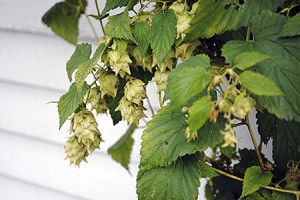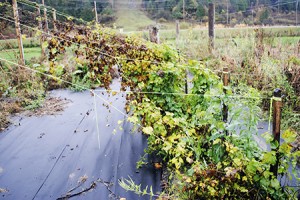

copyright the Chronicle October 22, 2014
by Aaron Dentel-Post
In 1850, Vermont grew 8.2 percent of the nation’s hops, with Orleans County accounting for 77,605 pounds of the crop a year. The crop was so important that children were taken out of school at harvest time, and men took time off from their regular jobs.
But it was the women, according to Kurt Staudter, executive director of the Vermont Brewers Association and author of Vermont Beer, who were paid the most because they were gentler when picking the easily bruised cones of the plant.
Prohibition, which began a leaky and tentative legacy in Vermont in 1853, eventually took its toll on hops production. But there were other factors, too. Plant disease, and large-scale West Coast production had killed production of the crop in Vermont by around 1910.
Now, the rise of craft brewing in the 1980s, and its subsequent explosion, have caused recent shortages of hops.
Professor Heather Darby of the University of Vermont has been working on bringing hops back to the state with cooperation from local brewers like Brian Cook of Kingdom Brewing in Newport Center and the Vermont Brewers Association.
Ms. Darby has been working on an organic hop varietal trial, which is in its third year. The study also looked at developing a mobile harvester several years ago that could be used on local farms.
The biggest barriers to hops farming are knowledge and production based, Ms. Darby said. One of the primary reasons hops aren’t widely grown in Vermont are the pests.
“This is sort of a learning curve for a lot of us, even those trying to help the farmers,” she said. “It’s a crop that requires a lot of management; it’s not like growing corn or soybeans.”
While the Pacific Northwest, where most hops are grown, is dry during the growing season, Vermont isn’t.
But there are varieties that can be grown more easily in this region. Cascade, which is a popular variety, Newport and Chinook hops are the easiest to grow in Vermont, according to Ms. Darby’s trial.
“There’s far more interest than there are hops,” she said.
Both Ms. Darby and Mr. Cook said that the scale of hops growing is important.
“What we sort of found is that to support the infrastructure, you have to have ten to 20 acres,” Ms. Darby said. “You have to get the yields.”
While barriers can seem high, so is the price of hops now, said Mr. Cook.
“I could use 30 pounds for one batch,” he said. “Some varieties have gone from six dollars to 12 dollars a pound.”
And, he said, the price will help Vermont by making entering the hops market more attractive.
“I think it could happen,” he said. “I’d love to make a completely Vermont beer.”
Mr. Cook said his ancestors grew hops in the 1700s. He thinks the best way to address the issue of scale is through a cooperative, similar to the Cabot Creamery or the West Coast hops cooperative Hopunion.
He said that a primary processing plant would mean that processing would be cheaper for individual farmers.
“We use pelletized hops, and a lot of local growers have no ability to pelletize them,” Mr. Cook said.
He said one of the issues with Vermont hops production was that too many farmers were trying to grow organic hops in a region that can be prone to dampness and downy mildew. The mismatch means that oftentimes crops are unnecessarily ruined.

“Only two breweries in Vermont brew organic beer,” said Mr. Cook.
He said Kingdom Brewing uses about 90 percent West Coast hops, but he also buys them from a grower on Burke Mountain.
“I think it will eventually get there,” he said. “There’s some uphill struggles through some brewers, but not me.”
Mr. Staudter said breweries, including Otter Creek, Lawson’s Finest Liquids, Stone Corral and Rock Art, are using at least some measure of local hops.
“They make it a big deal in their promotional material,” said Mr. Staudter.
He said growing hops involves some infrastructure investment to put up wires and posts for the plant, which grows much like a vine. The plants can also take a couple of years to start growing significant cones.
“Harvesting hops is very labor intensive,” he said.
Mr. Staudter said he grows hops in his back yard for his own home brewing, and his harvest can reach ten pounds before the drying process.
Lorie Seadale, who runs the River’s Edge Farm Stand in Barton, said she grew hops this past season. Though her crop is far too small to sell to craft brewers, she sold them to home brewers and an herbalist.
“I’m doubling the number of plants next year,” she said.
She said she grew Centennial, Cascade, Mount Hood and Willamette varieties. She hadn’t gotten a lot of sales or requests, but said it was just the first year and she wasn’t totally sure whether they would be good to use for beer.
According to Ms. Seadale, they grow well here, and the only trouble she had was from Japanese Beetles chewing on the leaves.
“I’m told by people who frequent the woods — loggers and such — that there are still wild hops growing,” Ms. Seadale said. “The first crop I had dried just fine.”
She said someone she knew from Massachusetts visited and was amazed that her plants had fared so well.
“His jaw just dropped when he saw my plants,” she said. “He couldn’t believe I had cones the first year.”
contact Aaron Dentel-Post at [email protected]
For more free articles from the Chronicle like this one, see our Featuring pages. For all the Chronicle’s stories, subscribe:
Print subscription
Annual online subscription
Short-term online subscription







